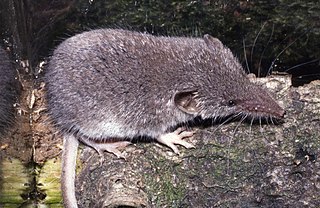
The common degu, or, historically, the degu, is a small hystricomorpha rodent endemic to the Chilean matorral ecoregion of central Chile. The name degu on its own indicates either the entire genus Octodon or, more commonly, just the common degu. Common degus belong to the parvorder Caviomorpha of the infraorder Hystricognathi, along with the chinchilla and guinea pig. The word degu comes from the indigenous language of Chile, Mapudungun, and the word dewü, meaning 'mouse' or 'rat'.

Octodon is a genus of octodontid rodents native to South America, in particular in the Chilean Andes. The best-known member is the common degu, O. degus, which is kept as a pet in various countries. Two of the four species of degus are nocturnal.

The eastern mole or common mole is a medium-sized North American mole. It is the only species in the genus Scalopus. It is found in forested and open areas with moist sandy soils in northern Mexico, the eastern United States and the southwestern corner of Ontario in Canada.

Mocha Island is a Chilean island located west of the coast of Arauco Province in the Pacific Ocean. The island is the location of numerous historic shipwrecks. In Mapuche mythology, the souls of dead people travel west to visit this island. The waters off the island are a popular place for recreational sea fishing.

The lesser white-toothed shrew is a small species of shrew with a widespread distribution in Africa, Asia and Europe. Its preferred habitat is scrub and gardens and it feeds on insects, arachnids, worms, gastropods, newts and small rodents, though its diet usually varies according to the biotope where it lives. The closely related Asian lesser white-toothed shrew was once included in this species, but is now considered to be a separate species.
Hutterer's brush-furred mouse or Hutterer's brush-furred rat is a species of rodent in the family Muridae. It is found only in Democratic Republic of the Congo, where its natural habitat is subtropical or tropical moist lowland forests.

Bennett's chinchilla rat is a species of chinchilla rat in the family Abrocomidae. It is found only in Chile where its habitat is Mediterranean-type scrub on the western side of the Andes. The IUCN has assessed its conservation status as being of "least concern".

The moon-toothed degu is a species of rodent in the family Octodontidae. It is endemic to Chile, occurring in mountainous areas along the Pacific coast in the central part of the country.

The mountain degu is a species of rodent in the family Octodontidae. It is the only species in the genus Octodontomys. It is found in the foothills of the Andes in Argentina, Bolivia and Chile.
The mountain viscacha rat or mountain vizcacha rat, historically viscacha rat or vizcacha rat, is a species of rodent in the family Octodontidae. It is endemic to Argentina.

The coruro is a species of rodent in the family Octodontidae. It is the only species in the genus Spalacopus. The species is endemic to central Chile, where it has been found in a wide variety of habitats, from coastal to montane. It is fossorial and lives in colonies.
Porter's rock rat is a species of rodent in the family Octodontidae. It is found in Argentina and Chile at altitudes between 900 and 2,000 meters above sea level.

Octodontidae is a family of rodents, restricted to southwestern South America. Fourteen species of octodontid are recognised, arranged in seven genera. The best known species is the common degu, Octodon degus.
Bridges's degu is a species of rodent in the family Octodontidae. It is found in southern Chile. The species was named after Thomas Bridges.
Kirchner's viscacha rat or Kirchner's vizcacha rat is a species of rodent in the family Octodontidae described in 2014. It is one of three species in the genus Tympanoctomys. That species is endemic to Chubut Province in the central western Argentina, where it has a fragmented range. Its natural habitat is desert scrubland, dunes and salt flats, where it eats halophyte plants. It is a solitary, nocturnal rodent that constructs large mounds with complex burrows. The species was named in honor of both Cristina Fernández de Kirchner and Néstor Kirchner, presidents of Argentina.
The Degus are a group of octodontid rodents in the Octodontidae family, but historically referred to the common degu.
Communal burrow refers to the habitat built by some species of mammals as a community habitat. There are some species that build burrows, but not communal burrows; and there are some species that live in communal groups, but do not construct burrows or any other type of habitat.
Ricardo Ojeda's degu is a species of rodent in the family Octodontidae. It is found in a small portion of eastern Chile and western Argentina, being the only degu found outside of Chile. It was named after Argentine mammalogist Ricardo Ojeda.











